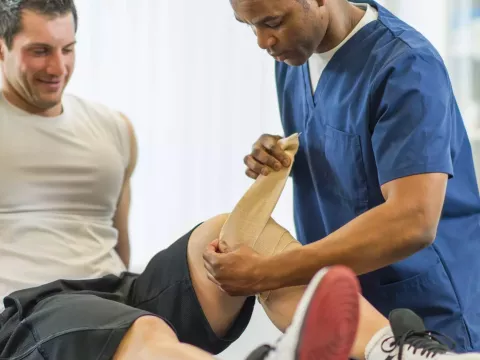- UChicago Medicine AdventHealth

Choose the health content that’s right for you, and get it delivered right in your inbox.
Harnessing your enthusiasm to exercise will carry you through the ebbs and flows that mark any exercise routine.
But running without a prevention plan is an invitation to injury. Tempering your eagerness to
move with steps to prevent injury can help you stay healthy - and active - for longer.
Plus, knowing you're prepared will give you confidence that you've created a sustainable habit instead of one waiting to be derailed.
CREATION Life, our philosophy for living whole, teaches us that simply making the choice to be active helps us realize we have control over our health. Taking that first step will help you regain control over your life, including your stress and anxiety.
Read on for tips on how to prevent injuries, including in children. Because sitting all day can weaken your body, we'll help you avoid the aches and pains caused by desk jobs, too.
Make Healthy Choices
Stretching, core strength, cross-training and gradually increasing intensity are key elements in staying healthy. The best tip to avoid injuries of any kind is to maintain a regular exercise schedule.
The CREATION Life approach teaches us to be active, but it’s flexible about how that looks for each unique person. Doing something you enjoy — like gardening, perhaps, or hiking a trail —will turn a chore into a fun and healthy choice.
You don’t have to be extreme, but having a normal routine that involves cardio, such as walking, swimming, cycling or hiking does wonders for your whole health.
Though many of us associate injury with misfortune on our feet — say, a trip, fall or twist — the opposite is true. Humans are not made to sit for long periods of time, and it’s this inactivity that is most dangerous.
Of course, starting an exercise routine is not easy. But here are some tips to help you sidestep the pain and frustration of injury.
Don't Rush It!
No matter where you start on a running journey, pace yourself to avoid pain and injuries, especially in the knees. As a rule of thumb, runners should run 10 percent farther each week.
In other words, if you're running 20 miles a week, don't jump to 40 even if you think you can handle it. Instead, try 22 miles the next week. As you ramp up, you'll make more progress each week than you did before, but in a sustainable way.
It's a slower road, but by far the safer one.
Mix it Up
Perhaps the best way to prevent running injuries is to broaden your exercise horizons. You can opt to bike, swim or try another form of exercise. It's the best thing you can do to prevent injuries.
Runners, whose joints are subjected to repeated stress, can supplement their routine with low-impact workouts such as bicycling and swimming. This provides rest for battered joints without stopping your workouts.
Plus, it works different muscles, and in new ways, providing benefits to your overall strength and conditioning.
Stretch Warm
Despite the key role of flexibility and mobility in preventing injury, there continues to be a debate about the role of stretching.
Runners are advised to warm up before physical activity, but save the toe touches and back bends until you're done.
Brisk walking or a light jog before exercising and holding off on static stretches until afterward is the safest approach to stretching.
Kids and Exercise
For children, strength training should not be a priority. However, there is a safe amount of exercise to help them learn to move and control their bodies.
It's important to teach children the big picture about movement, repetition and practice. Overuse injuries are an ever-larger problem, especially with children who play for multiple competitive teams, including baseball.
Children should also feel comfortable admitting pain or fatigue, either of which can signal an overuse injury.
Sometimes, kids don't tell parents or coaches when they're hurt, so you have to encourage
open communication.
Work Out at Work
A desk might seem like a pretty safe place. But physical therapists see plenty of patients whose pain can be traced to inactivity.
We're not made to sit for long periods of time. Unfortunately, the most comfortable position can be the most damaging. A bad posture is usually a position of comfort, and these habits are particularly damaging to our necks.
As humans in the digital age, so much strain is put on our necks, whether it's strain from leaning forward at a desk monitor or tilting forward to gaze at a phone.
Here are a few general tips to create a safe workstation:
- The computer monitor should be just below eye level, so you don't have to move your head to see it.
- Your arm should be resting on an armrest, even or nearly so with your wrists and hands.
- Sit against a backrest with your feet on the ground and your knees at a 90-degree angle.
Standing desks, including those that allow for an easy transition between sitting, are quite helpful.
There are also steps you can take to avoid injury without even getting up. Here are a few:
- Shoulder rolls: Rotate your shoulders in a circular motion, forward and backward.
- Neck stretch: Sitting with your feet on the ground and shoulders back, grab your chair with your left hand. Then slowly bring your right head toward your right shoulder until you feel a gentle stretch. Hold this for 10 seconds and repeat on the opposite side.
Stretches done over a few minutes one or two times a day can really help out somebody in the long run.
To Avoid Knee Pain, Look to the Hip
Knee pain is quite common in runners, and a lot of it can be avoided with better muscle strength.
Targeted exercises at the hip are recommended, though the intensity will vary based on your ability.
A good place to start is with clamshells, which are performed while laying on your side with knees bent. Slowly raise and lower your top knee.
A more advanced version of this exercise involves planking — holding your core and legs straight. On your side, place your right forearm along the ground and lift your hips in the air so that your body is in a straight line. Then lower your hips to the ground and lift them back up in the air.
Get Motivated
While physical trainers can teach, support and point their patients in the right direction, it's up to you to do the work.
For UChicago Medicine AdventHealth physical therapists, uncommon compassion means enlisting patients as full partners in recovery and prevention.
A UChicago Medicine AdventHealth physical therapist can arrange the elements of prevention — including stretching, cross-training and gradual intensity increases — in a way that fits into your unique life.
Making the choice to take control over your health will help you feel better and brighten your outlook. After all, CREATION Life tells us that our mind and body work together to shape our whole health.
To schedule an appointment with our expert team, visit us here. You deserve to feel whole.


